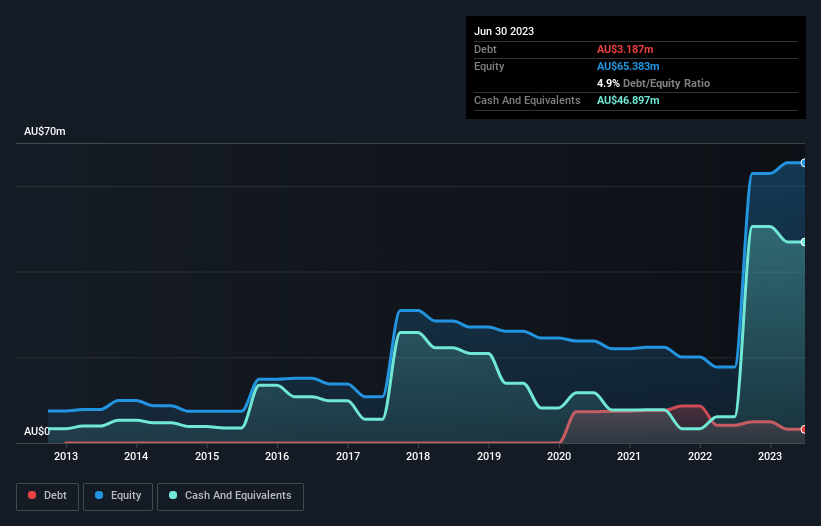Howard Marks put it nicely when he said that, rather than worrying about share price volatility, 'The possibility of permanent loss is the risk I worry about... and every practical investor I know worries about.' So it seems the smart money knows that debt - which is usually involved in bankruptcies - is a very important factor, when you assess how risky a company is. As with many other companies PolyNovo Limited (ASX:PNV) makes use of debt. But the real question is whether this debt is making the company risky.
When Is Debt A Problem?
Debt assists a business until the business has trouble paying it off, either with new capital or with free cash flow. Ultimately, if the company can't fulfill its legal obligations to repay debt, shareholders could walk away with nothing. However, a more frequent (but still costly) occurrence is where a company must issue shares at bargain-basement prices, permanently diluting shareholders, just to shore up its balance sheet. By replacing dilution, though, debt can be an extremely good tool for businesses that need capital to invest in growth at high rates of return. When we examine debt levels, we first consider both cash and debt levels, together.
Check out our latest analysis for PolyNovo
How Much Debt Does PolyNovo Carry?
As you can see below, PolyNovo had AU$3.19m of debt at June 2023, down from AU$4.13m a year prior. However, its balance sheet shows it holds AU$46.9m in cash, so it actually has AU$43.7m net cash.

How Strong Is PolyNovo's Balance Sheet?
The latest balance sheet data shows that PolyNovo had liabilities of AU$12.7m due within a year, and liabilities of AU$14.6m falling due after that. Offsetting this, it had AU$46.9m in cash and AU$13.7m in receivables that were due within 12 months. So it can boast AU$33.4m more liquid assets than total liabilities.
This surplus suggests that PolyNovo has a conservative balance sheet, and could probably eliminate its debt without much difficulty. Succinctly put, PolyNovo boasts net cash, so it's fair to say it does not have a heavy debt load! There's no doubt that we learn most about debt from the balance sheet. But ultimately the future profitability of the business will decide if PolyNovo can strengthen its balance sheet over time. So if you're focused on the future you can check out this free report showing analyst profit forecasts.
In the last year PolyNovo wasn't profitable at an EBIT level, but managed to grow its revenue by 57%, to AU$66m. With any luck the company will be able to grow its way to profitability.
So How Risky Is PolyNovo?
By their very nature companies that are losing money are more risky than those with a long history of profitability. And in the last year PolyNovo had an earnings before interest and tax (EBIT) loss, truth be told. Indeed, in that time it burnt through AU$8.1m of cash and made a loss of AU$4.9m. With only AU$43.7m on the balance sheet, it would appear that its going to need to raise capital again soon. With very solid revenue growth in the last year, PolyNovo may be on a path to profitability. By investing before those profits, shareholders take on more risk in the hope of bigger rewards. The balance sheet is clearly the area to focus on when you are analysing debt. But ultimately, every company can contain risks that exist outside of the balance sheet. For example, we've discovered 1 warning sign for PolyNovo that you should be aware of before investing here.
If, after all that, you're more interested in a fast growing company with a rock-solid balance sheet, then check out our list of net cash growth stocks without delay.
New: Manage All Your Stock Portfolios in One Place
We've created the ultimate portfolio companion for stock investors, and it's free.
• Connect an unlimited number of Portfolios and see your total in one currency
• Be alerted to new Warning Signs or Risks via email or mobile
• Track the Fair Value of your stocks
Have feedback on this article? Concerned about the content? Get in touch with us directly. Alternatively, email editorial-team (at) simplywallst.com.
This article by Simply Wall St is general in nature. We provide commentary based on historical data and analyst forecasts only using an unbiased methodology and our articles are not intended to be financial advice. It does not constitute a recommendation to buy or sell any stock, and does not take account of your objectives, or your financial situation. We aim to bring you long-term focused analysis driven by fundamental data. Note that our analysis may not factor in the latest price-sensitive company announcements or qualitative material. Simply Wall St has no position in any stocks mentioned.
About ASX:PNV
PolyNovo
Designs, manufactures, and sells biodegradable medical devices in Australia, New Zealand, the United States, the United Kingdom, Ireland, Singapore, India, and Hong Kong.
Flawless balance sheet with high growth potential.
Market Insights
Community Narratives




